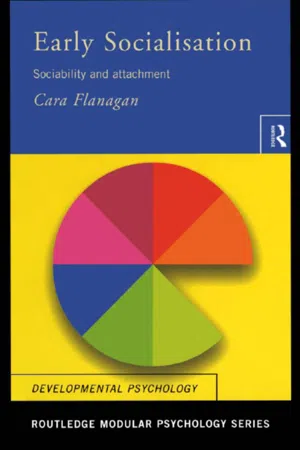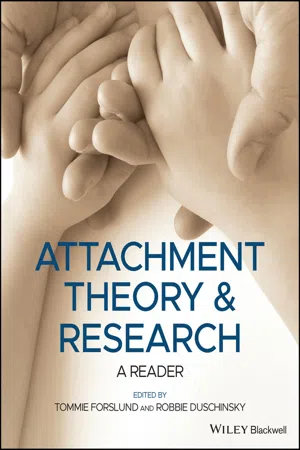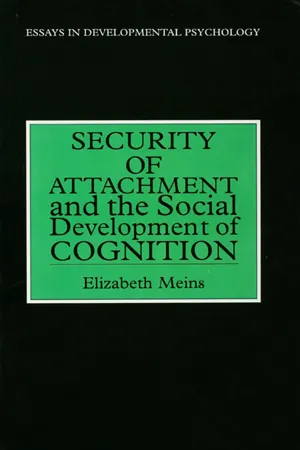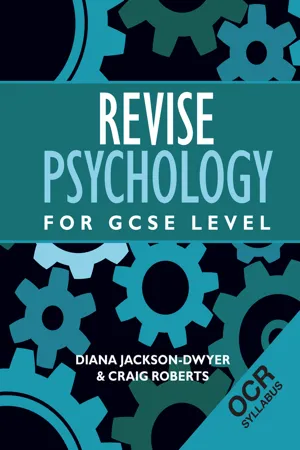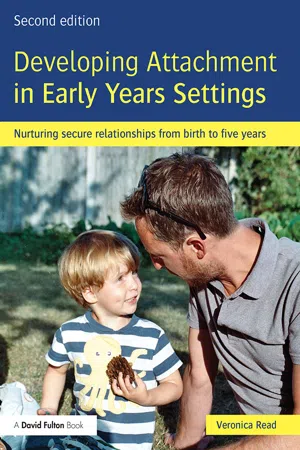Bowlby's Monotropic Theory
Bowlby's Monotropic Theory suggests that infants form a special attachment to one primary caregiver, usually the mother, which serves as a secure base for exploring the world. This attachment figure provides a sense of security and comfort, influencing the child's emotional development and future relationships. Bowlby emphasized the importance of this early attachment for a child's social and emotional well-being.
7 Key excerpts on "Bowlby's Monotropic Theory"
- eBook - ePub
Early Socialisation
Sociability and Attachment
- Cara Flanagan(Author)
- 2002(Publication Date)
- Routledge(Publisher)
...Cross-cultural research (see Chapter 7) in general supports this in showing that infants do appear to form a primary attachment in all cultures. But there are exceptions, and there are cultural variations in the way that people in different cultures relate to their infants. Therefore we might conclude that aspects of attachment are innate. Monotropy In the early version of attachment theory, Bowlby introduced the term ‘monotropy’ to describe the fact that the child had one primary attachment figure (see p. 51). Bowlby always maintained that the child had many different attachments but they were not equivalents of each other. They formed a hierarchy with the maternal or primary caregiver at the top. The importance of the primary caregiver lies in the model this provides for all subsequent relationships. It is this attachment, above all others, which has important and long-term emotional consequences. The mechanism by which this takes place is through the internal working model. The internal working model The internal working model is a set of conscious and/or unconscious rules and expectations regarding our relationships with others. This model develops out of the primary attachment relationship and is what it sounds like, a model or schema which is used as the template for future relationships. Through this first emotional relationship the child is able to build up a set of models of themselves and of others. The securely attached child should have a positive picture of themselves and will be able to bring this to other relationships. The insecurely attached child sees themselves as unworthy of love and is therefore reluctant to enter into relationships. One difficulty with this concept is the fact that it is hard to test empirically. Caregiver sensitivity hypothesis Holmes (1993) called Mary Ainsworth the ‘co-founder of attachment theory’ in her work with Bowlby...
- eBook - ePub
Attachment Theory and Research
A Reader
- Tommie Forslund, Robbie Duschinsky, Tommie Forslund, Robbie Duschinsky(Authors)
- 2021(Publication Date)
- Wiley-Blackwell(Publisher)
...Much depends on the infant’s representational model of its mother, the state of activation of the attachment system relevant to other behavioral systems, and the nature of the specific situation in which the infant finds itself. It is the whole pattern of organization of a child’s behavior as it is manifested across a variety of behavioral and environmental contexts that enables one to identify a child’s attachment figures. The issue of monotropy Throughout his discussion of the early phases of the development of attachment, Bowlby (1969) acknowledged that an infant may become attached to more than one figure, although he emphasized that attachment figures are necessarily few in number. Nevertheless, he does not consider all a child’s attachment figures equal in significance; a baby tends to become especially attached to one figure – the principal caregiver or mother figure. This tendency Bowlby attributes to a principle of “monotropy,” which implies the likelihood of a hierarchy of attachment figures – one principal attachment figure together with one or a few subsidiary figures. Under nonstressful conditions it may be difficult to identify the principal attachment figure, for a child may seek proximity to, interaction with, or even contact with several persons, seeming to prefer first one and then another. But under stressful conditions that activate attachment behavior at high intensity, a child will by preference seek proximity to and contact with the principal figure rather than a secondary attachment figure if both are equally available to the child. Lamb’s (1977) findings support this notion...
- Elizabeth Meins(Author)
- 2013(Publication Date)
- Psychology Press(Publisher)
...The mother figure thus has an important role to play in establishing the attachment relationship, since she must respond to her child’s cues, maintaining the dynamic system involved in the “social releaser—instinctive response—social suppressor” behaviour pattern. Bowlby summarised his theory as follows: “There matures in the early months of life of the human infant a complex and nicely balanced equipment of instinctual responses, the function of which is to ensure that he obtains parental care sufficient for his survival. To this end the equipment includes responses which promote his close proximity to a parent and responses which evoke parental activity” (ibid, p.346). Despite the fact that Bowlby”s blend of ethology and psychoanalysis represented a major improvement on anything that had previously been written on the nature of the infant-mother tie, his theory still had its shortcomings. Perhaps the two most common criticisms of Bowlby’s early work were his concentration on a single attachment relationship between infant and mother, and his generalisation from clinical observations of children to “normal” children being reared at home. In the original theory, these two views are related to one another. Again using ethological data to back up his claims, Bowlby asserted that infants learn to centre their instinctual responses on their mother: “good mothering from any kind of woman ceases to satisfy [the infant]—only his own mother will do” (ibid, p.370). Bowlby termed this direction of instinctual responses exclusively towards the mother monotropy, and believed that the mother was responsible for facilitating the infant’s integration into the social world. Furthermore, Bowlby argued that the mother’s repeated rejection of such responses would lead to psychological damage in the child. Specifically, Bowlby said that infants incurred the worst damage if their mothers did not accept their infants’ clinging and following responses...
- eBook - ePub
- Diana Jackson-Dwyer, Craig Roberts(Authors)
- 2015(Publication Date)
- Psychology Press(Publisher)
...The tendency to bond with one main person is called monotropy. • There is a critical period, from 7 months to 3 years, during which the baby is most likely to form this attachment bond. If it is not formed by the age of about 3 years it is unlikely to form at all and the child may never attach to anyone. • The first attachment serves as an internal working model, which is the basis of our expectations and rules regarding relationships in later life. The effects of deprivation and privation Bowlby’s theory of what happens if the bond is not formed properly is as follows. Short-term effects Robertson and Robertson suggested that when children are first separated from their mother or mother substitute they go through three stages of reaction, known as the syndrome of distress. Stage 1: Protest Child attempts to follow the mother, scream and do everything they can to recover her. The child will continue looking for her long after she has gone Stage 2: Despair Child will often sob but in a more "helpless" way, making far fewer attempts to find the mother. The child tends to show a distinct loss of hope. Stage 3: Detachment Child appears calm and even "settled". However, this apparent calm often masks underlying distress...
- eBook - ePub
From Broken Attachments to Earned Security
The Role of Empathy in Therapeutic Change
- Andrew Odgers(Author)
- 2018(Publication Date)
- Routledge(Publisher)
...The impact of these ideas on the development of the care of children in hospital has been enormous. The 2001 John Bowlby memorial lecturer, Michael Rutter, discussed institutional care and the role of the state in promoting recovery from neglect and abuse. His lecture was a testament to the continuing relevance of Bowlby’s thinking to contemporary social issues. Although Bowlby joined the British Psychoanalytical Society in the 1930s and received his training from Joan Riviere and Melanie Klein, he became increasingly sceptical of their focus on the inner fantasy life of the child rather than real life experience, and tended towards what would now be termed a relational approach. Thus, in searching for a theory which could explain the anger and distress of separated young children, Bowlby turned to disciplines outside psychoanalysis such as ethology. He became convinced of the relevance of animal and particularly primate behaviour to our understanding of the normal process of attachment. These relational concepts presented a serious challenge to the closed world of psychoanalysis in the 1940s, and earned Bowlby the hostility of his erstwhile colleagues for several decades. The maintenance of physical proximity by a young animal to a preferred adult is found in a number of animal species. This suggested to Bowlby that attachment behaviour has a survival value, the most likely function of which is that of care and protection, particularly from predators. It is activated by conditions such as sickness, fear, and fatigue. The threat of loss leads to anxiety and anger; actual loss leads to anger and sorrow. When efforts to restore the bond fail, attachment behaviour may diminish, but will persist at an unconscious level and may become reactivated by reminders of the lost adult, or new experiences of loss. Attachment theory’s basic premise is that, from the beginning of life, the baby human has a primary need to establish an emotional bond with a caregiving adult...
- eBook - ePub
Talking Bodies
How do we Integrate Working with the Body in Psychotherapy from an Attachment and Relational Perspective?
- Kate White(Author)
- 2018(Publication Date)
- Routledge(Publisher)
...The impact of these ideas on the development of care of children in hospital has been enormous. The 2001 John Bowlby Memorial Lecturer, Michael Rutter, discussed institutional care and the role of the state in promoting recovery from neglect and abuse. His lecture was a testament to the continuing relevance of Bowlby’s thinking to contemporary social issues. Although Bowlby joined the British Psychoanalytical Society in the 1930s and received his training from Joan Riviere and Melanie Klein, he became increasingly sceptical of their focus on the inner fantasy life of the child rather than real life experience, and tended towards what would now be termed a relational approach. Thus, in searching for a theory that could explain the anger and distress of separated young children, Bowlby turned to disciplines outside psychoanalysis such as ethology. He became convinced of the relevance of animal, and particularly primate, behaviour to our understanding of the normal process of attachment. These relational concepts presented a serious challenge to the closed world of psychoanalysis in the 1940s, and earned Bowlby the hostility of his erstwhile colleagues for several decades. The maintenance of physical proximity by a young animal to a preferred adult is found in a number of animal species. This suggested to Bowlby that attachment behaviour has a survival value, the most likely function of which is that of care and protection, particularly from predators. It is activated by conditions such as sickness, fear, and fatigue. Threat of loss leads to anxiety and anger; actual loss leads to anger and sorrow. When efforts to restore the bond fail, attachment behaviour may diminish, but will persist at an unconscious level and may become reactivated by reminders of the lost adult, or new experiences of loss. Attachment theory’s basic premise is that, from the beginning of life, the baby human has a primary need to establish an emotional bond with a caregiving adult...
- eBook - ePub
Developing Attachment in Early Years Settings
Nurturing secure relationships from birth to five years
- Veronica Read(Author)
- 2014(Publication Date)
- Routledge(Publisher)
...It will enable them to feel supported in their exploration, curiosity and learning. John Bowlby, the father of attachment thinking, called this a secure base, a trusted figure from whom to set off and to return to as a safe haven, whenever necessary. Being in relationship with a trusted and responsive adult allows a child to return to base, to emotionally refuel and recover before setting off again, curious and hopeful that the next new experience can be managed. John Bowlby (1907–90), the father of attachment theory John Bowlby, the father of attachment theory, first drew our attention to the ways in which adults and children: communicate and develop in relation to each other in the first years of life; respond when they are presented with real-life events which make them feel anxious and frightened. Who was John Bowlby? He was born in 1907. He was the fourth of six children. His parents were middle aged by the time he was born. Parents at this time were often more distant in their parenting than they might be today. His primary carers were his nurse maid, Minnie and his nanny, Nanny Friend. His parents like many others at this time may have been preoccupied by talk of war. During the First World War (1914–18) his father was dealing directly with loss as an army surgeon. In 1914, aged seven, John was sent to boarding school with his brother. John was a successful student. After a brief period in the Navy, he chose a career in medicine, like his father. When he left Cambridge he decided to work with disturbed adolescents. He became interested in the link between children’s early lives and their later disturbance. He developed an interest in psychoanalysis and child psychiatry. His...
